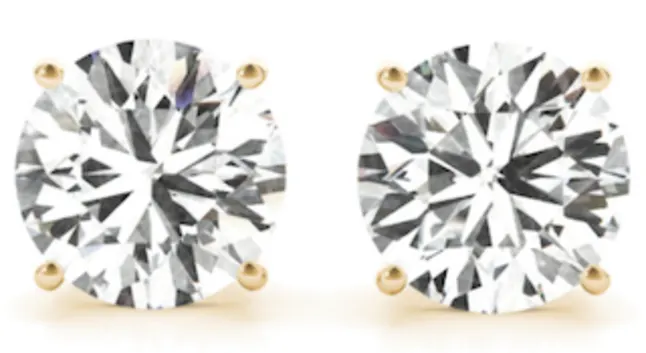2 Carat Diamond Stud Earrings | Rare Carat
I love stud earring for their simple, timeless, classy aesthetic that is versatile for both fancy occasions and as modest everyday wear. These earrings are designed to showcase the beautiful solitaire diamond like it should be, which keeps our design options easy and minimal. I will cover these basic styles, but I’ll also tackle our very essential 4C’s of diamonds so you will feel confident in knowing exactly what you want, plus the quality of diamonds you are looking for, before you even start your shopping. Get excited because you, my friend, are about to become an expert on studs in a very short period of time!
Design Options
There are 3 basic design choices you will have when considering your diamond stud earrings - diamond shape, diamond setting, and metal selection. Each of these are very uncomplicated decisions, yet each are crucial to the overall aesthetic of the earrings.
Diamond Shape
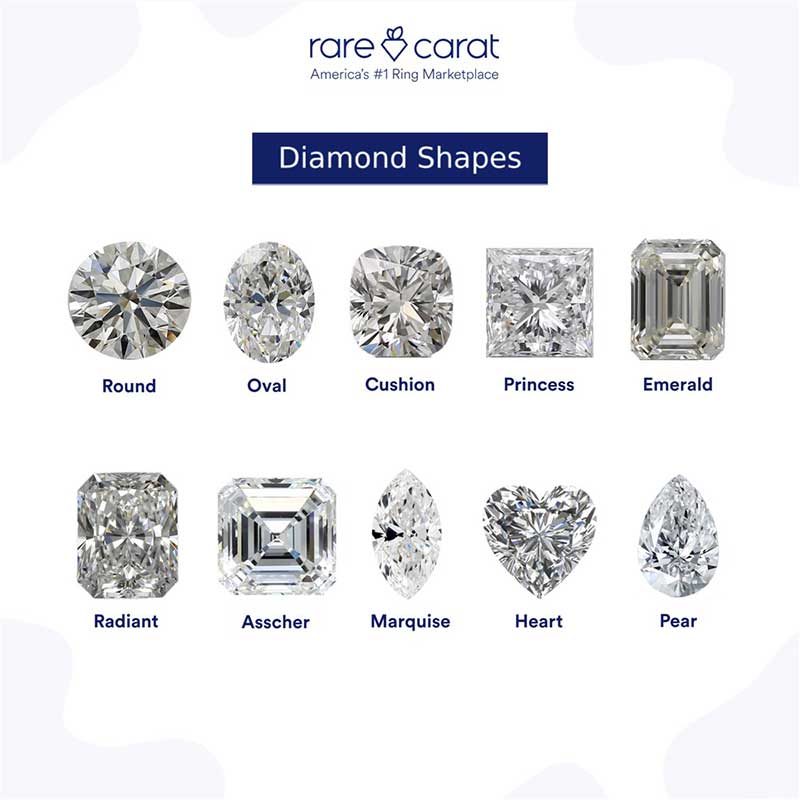
Okay so this decision will be the most obvious when looking at your studs because - duh, it is the literal shape of the earring. Easily the most popular stone is the round brilliant cut diamond. It already says it in the name but the reason they are so popular is because of the way rounds are cut. This shape allows light to properly bounce around and do its thing- really giving us some of the brightest and most dazzling effects that are desired from our diamonds (aka “brilliant” cut). The circular shape itself is also soft and calming, and I think people really connect with that…
That being said, of course other shaped diamonds can be studs as well. We see asscher and princess cuts used pretty often as the alternative to our round brilliant cut. These are both square shaped diamonds, with the difference being that the asscher cut has cropped corners while the princess does not. Some people are circle people, some people are square people, but just know both possibilities are equally ridiculously beautiful.
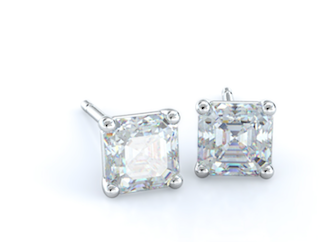
Other shapes, like hearts, ovals, marquise, etc. are fun but can also be hard to match perfectly - especially at the larger 2 carat size. The symmetry of every 2 carat heart shaped diamond, for instance, won’t be the same. I mean imagine trying to draw two hearts perfectly, let alone cutting two heart shaped diamonds exactly the same… which is probably frustrating for someone out there spending a lot of time attempting to source identically shaped heart diamonds. The benefit of earrings though is that there is an entire head between the two ears so slightly un-matching hearts may not be as obvious as if they were sitting side by side.
Diamond Settings
A setting is literally what holds the diamond securely in place in a piece of jewelry. For diamond stud earrings we usually only see 2 main setting types… which can be really nice when having to make a final style decision.
The Prong
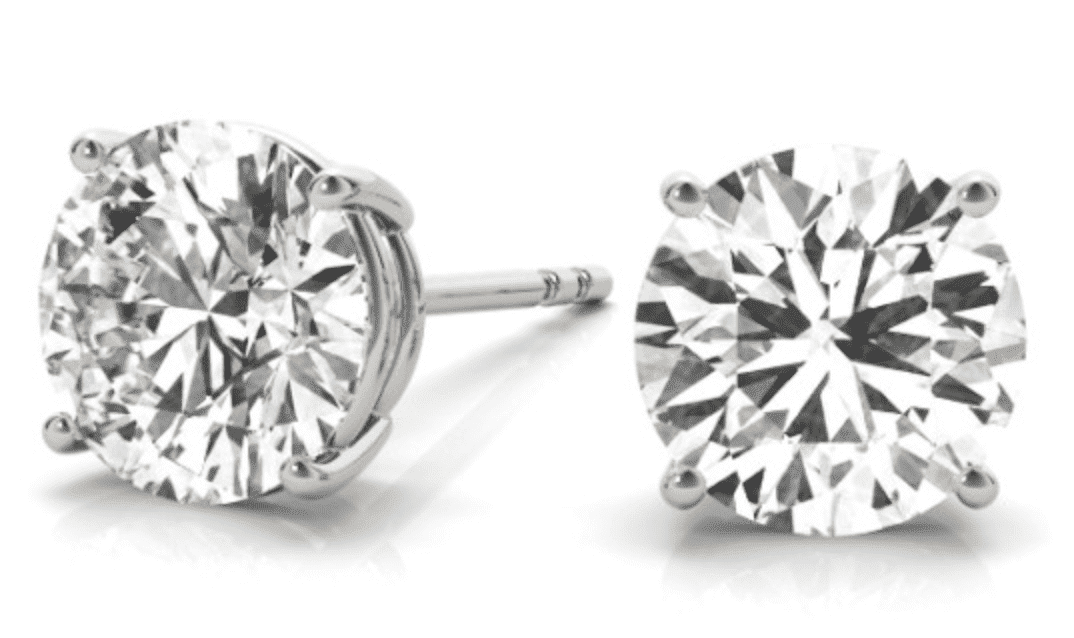
By far, the prong setting is the number one setting for stud earrings. This is a classic design where the diamond is gripped by a little metal claw. The prongs of the claw come up and over the diamond to hold it in place- making this a very simple, very secure setting.
The main benefit of the prong setting it that it allows light to fully penetrate the diamond. Diamonds are cut to specific angles so that light can’t escape, which forces it to be reflected back at you in those brilliant sparkles and flashes we see. Allowing the maximum amount of light in will create the maximum amount of sparkle to come out.
There are a couple drawbacks to the prong that are actually ironically caused by the prongs themselves. For one, the tips of the prongs can snag on soft materials, like a sweater being pulled too close to the ears or a beanie being pulled down too far. Obviously this isn’t the worst thing but it can be slightly annoying… which leads us to my second point. You will want to have the prongs check at least once a year throughout life to make sure they haven’t loosened at all. This setting is very secure, but it needs just a touch of maintenance to stay that way.
The Bezel
If you are looking for something a little different than the standard prong, we have the bezel setting! This setting has metal that fully encloses the bottom of the diamond, with a thin metal strip running along the top outline of the stone. The bezel definitely has a distinctive look that creates an overall modern design aesthetic for the earrings.
Because the diamond is completely surrounded by metal, it is extremely well protected (even more so than the ultra-safe prong), which is the major pro to a bezel set diamond. The sleek design is also great since it won’t snag on clothing like a prong might. This is perfect for anyone who might plan on wearing their studs during vigorous type activities.
On the flip side, completely enclosing the diamond with metal can make the stone appear slightly smaller (which is never a goal let’s be real). More importantly, though the bezel won’t let light fully enter the diamond like the open sided prong does… so if there is less light infiltration happening, then there will be less sparkle occurring.
The Halo
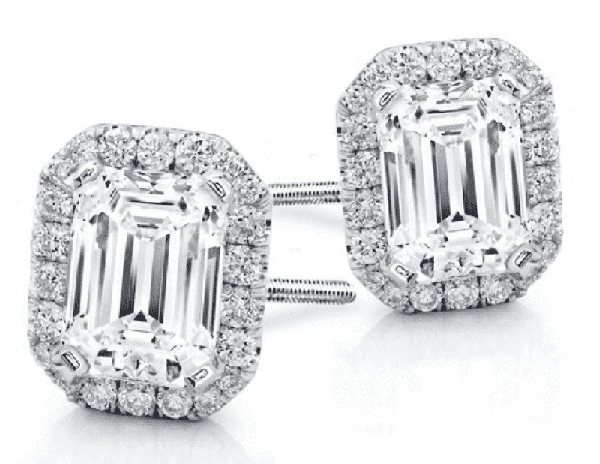
And just for honorable mention, we do see the halo setting on stud earrings occasionally. Usually, the halo is picked because it is beneficial in creating a larger looking diamond… but at 2 carats this definitely is not necessary. But! If you are just a halo lover in general or want the biggest look possible, then the halo could totally be perfect for you.
Metal Options

The last of our design choices is the metal option, and really we only favor a few select materials. Platinum would be the most popular for the white metals, with yellow gold being the best option for yellow metals. White gold and rose gold are also really great choices for studs if you want to get crazy.
This is pretty much purely a personal preference call, but I do have one tip for you- white metals will look best with colorless diamonds, giving the style a crisp, clean feel, while yellow metals will look best with yellowish tinted diamonds, creating a warm and romantic visual effect. Truly though, whatever you love here is the perfect choice.
Dimond Quality: The 4 C’s
The 4C’s are cut, color, clarity, and carat weight, and were created so we could have a universal standard for diamond grading. The grade indicates the quality of the diamond, and the quality of the diamond establishes the price- which is exactly why knowing the basics is important to us!
Cut

The cut of the diamond, which is usually confused with the shape of the diamond, is how well the rough stone was cut into the finished faceted diamond we all know and love. Proportions and symmetry are huge for establishing the cut grade, which ranges from excellent to poor. The best cut diamonds will have that dazzling display of brilliance and fire, while poorly cut diamonds can look dull or fuzzy.
Color
Because the majority of colorless diamonds in the world actually have a yellow or brownish tint, a true colorless diamond is rare (and expensive). The diamond color scale spans from D-Z, or colorless to slightly colored. Really, it is pretty subtle coloring until around the J-K range, so diamonds graded above this will probably appear colorless to the average person. This is a great tip for budget since colorless looking diamonds are similar to true colorless diamonds, but their prices are not.
Clarity
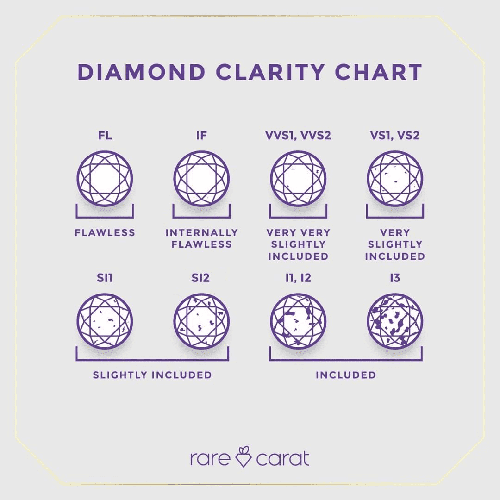
Flawless, by definition, is to be perfect… which is exactly where our clarity grading scale begins. The scale breakdown is FL (flawless), IF (internally flawless), VVS (very, very slight), VS (very slight), SI (slightly included), and I (included) -being obviously included diamonds. The sweet spot for eye-clean diamonds is the VS grade where the inclusions are large enough for the diamond to be more affordable, but still small enough to not be seen without magnification.
The ultimate greatest value in a diamond clarity though is if you can find SI1 diamonds that look eye clean… which is definitely possible! In fact, for our budget conscious earring buyers, I would recommend something within the SI range because no one is going to be up close enough to your ears to be looking that hard anyways.
Carat Weight
We weigh diamonds universally by using carat weight as the standard metric (1 carat = .200 grams). This one is easy for us because we already know we want 2 carat studs. This size is big and bold and definitely sexy. I love a big diamond, or two, so I fully support the 2 carat stud call.
If you happen to be looking for another budget tip though, check out diamonds that weigh right under the 2 carat mark… like a 1.97 or 1.98. These weights are under the “golden weight” of a perfect 2.00 carats, which makes them noticeably less expensive for diamonds that look pretty much like the same size.
Diamond stud earrings are classy AF. They are simple, elegant, and are solely designed to showcase our fabulous diamonds like the true showstoppers they are. Having a general idea of what you are looking for is always helpful before shopping, especially when it comes to diamonds... So, from design to quality- I have total confidence that you are now an official expert on diamond stud earrings!
